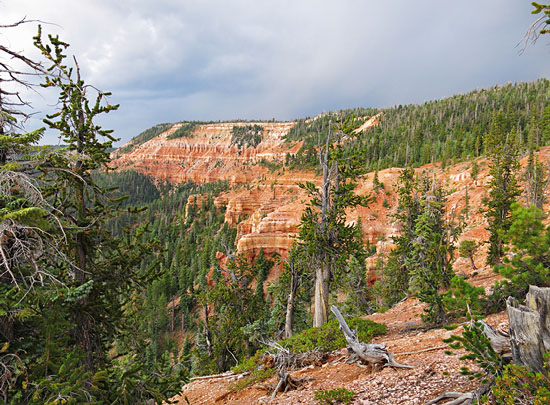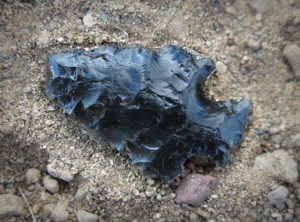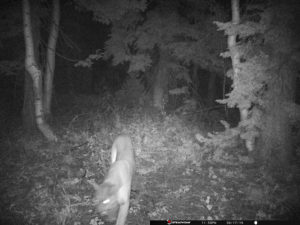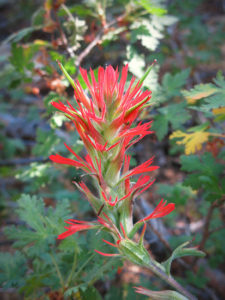
A Grim Assessment
Walking down the dusty trail in the dark, I grumbled, “Even if I do write a story about this hunt, it’ll be a short one: Every day was horrible, and then it ended”.
“Well, it’s not over yet,” Esther replied.
I wished it was.
It was a strange hunt, and a strange year. Winter arrived late and went long, as did spring and then summer, throwing the entire year one month late. So August was really July, and therefore the deer took their time migrating up the mountain, resulting in half the deer. Add to that an ever-increasing amount of human-hunters—twice as many as past years—and you have the perfect storm: Twice the dudes; half the deer.
Aside from that, I was about to nuke my entire known life and move to the boonies—300 miles away—in desperate attempt to salvage what good years I have left far away from the stifling mass of humanity. All of springtime I spent finishing my basement in anticipation of selling my Hooper home. The worst case scenario was to sell my home during the hunt, which would force me to abandon the hunt early to move. So of course, that’s what happened.
Since the August opener was really July, the weather was unseasonably hot and dry, creating a forest substrate like potato chips everywhere you went. No matter how carefully we moved, the deer always heard us coming, forcing us to hunt on established hiking and game trails, a low probability venture indeed.
The opener also coincided with a glaring full moon. This is bad for hunting because it allows deer to feed and move more at night, making them harder find during the day. Add to that a billion yellow-jackets and flies constantly circling your face, and conditions couldn’t be worse.
All that aside, I was deer hunting, so I was hopeful and happy. Amidst constant complaints I held fast to my goal: to shoot a great buck over 200 inches. It’s been way too long since I arrowed a true trophy buck, and I was determined to make this my year. Well, I might have picked the wrong year to reinvent myself…
Opening Day
My goal was to pick up where I left off last year. Last year I didn’t find the “land of giant bucks” until twenty days into the hunt. This year I headed up before light on opening day, climbing a thousand vertical feet through heavy timber, but nobody was home. The next day was the same, and so I began exploring other areas. As soon as I left my area, some clowns (other hunters) moved in, bombarding it morning and night. By the time I determined there were no other good areas, the clowns moved out and I moved back in.
Late one evening, as I sat in ambush at a historical deer crossing, a true giant with wide-sweeping antlers showed up. Unfortunately he was out of range, and it was too dark to count points. As nighttime swallowed him up, I began my 1000-foot timber descent back to the truck. With newfound hope, I tried a morning ambush. This time the deer sniffed me out from below and blasted away.
That evening found me in the same spot, but just as the buck’s sentinel materialized, a mysterious nighttime wind shifted upwards and blew the deer out. The following evening I chose a different approach, but the mysterious winds still blew uphill, and the deer never showed. Now, everyone knows that cooling air blows downhill in the evening. It’s simple physics: cold air falls. But not here, not in the “Bermuda Triangle.”

That’s when it hit me: the biggest, baddest, unhuntable stud-bucks used this area because there’s no way to get in front of them without being winded. Mornings are even worse because, as the deer work uphill from feeding, the warming air follows them, negating a stalk from below. An ambush from below also means chasing bucks over crunchy ground, which is impossible. Either way, those bucks winded me for the last time and left the mountain for goods. Back to the drawing board.
Slivers of Timber
In this age of high hunting pressure and long-range weaponry, big bucks adapt quickly or die. The first thing they do is move as far from people and roads as possible, living on extremely steep slopes, the kind of stuff mountain goats like. Next they go nocturnal. Bucks are mostly nocturnal in the first place, but big bucks are completely nocturnal. The only reason we ever catch them on their feet is because they have a hard time differentiating complete blackness from twilight. If you happen to catch a group of elk or deer feeding in the morning, you’ll notice they really don’t get moving until the sun crests the horizon, and then they’re gone. This is probably the most frustrating part the early season: you only get two slivers of daylight each day to catch them moving: 30 minutes in the morning and 30 minutes at night.
After that, they’re headed to fragile bedding areas which should be avoided at all costs. If you bust a buck from his “hard bed” (primary daytime bed), he’ll leave the area for the rest of the season. Thus, the best daytime strategy seems to be returning to your boring camp and wasting the entire day sitting around waiting for the next sliver of time to make your move.
The long-range rifle, which has gained popularity over the last decade or so, has had the greatest observable impact on big game animals. My recent extended stints in the woods have shown that deer antlers are narrowing. They still grow the same amount of bone on their heads, but it’s much more vertical than horizontal. Reason being—of course—is that deer are holding tighter to the timber, and a wide rack only slows them down.
Perhaps the animal most affected by long-range rifles is the pronghorn (antelope). Esther drew a limited antelope tag this year, and when I took a day off deer to and help her, it took less than 12 hours to realize I couldn’t. The only way to locate the sparse antelope was to drive the vast dirt roads and glass. But whenever the antelope spied a vehicle, even a mile away, they’d take off at a dead run until they were miles farther. These poor speed goats spend their entire lives in the open sagebrush. Over the years, long-rangers have sniped them from the road at unconscionable distances of half a mile or more! Esther’s only real chance was to pick a random water hole and sit in a ground blind for days at a time. It almost worked too, but that’s another story.
Inevitably, modern big game animals are growing more cautious. If you’re lucky enough to find a mountain with high deer density, you’ll still have a near-impossible time locating the giants. Giant bucks are only found in tiny slivers of terrible timber on steep, high-elevation slopes. Using territoriality, they take over the deepest woods where the wind is always in their favor. They live by their over-sized snouts, using scent rather than sight to dictate their movements.

When hunting in dense timber, it’s almost impossible to verify a deer that you’ve spooked because of how they move. Big bucks don’t just beeline away, but rather dive behind the nearest tree(s), and then zigzag from cover to cover, ensuring the hunter never gets a clear shot. Even unpressured bucks zigzag through cover throughout their daily movements. If you get a chance to track a big buck, you’ll notice he rarely travels in a straight line, but moves from cover to cover, always avoiding open areas. On top of that, deer make very little noise when moving. The same crunchy ground that makes a hunter sound like a bulldozer is nearly inaudible with a deer’s carefully placed hoof.
Finally, ‘big bucks’—any buck over five years old and having antlers scoring over 180-inches—are extremely rare on public land. How rare? In thirty years of deer hunting I haven’t found an area/unit/region where more than two percent of the bucks meet trophy criteria. Skillful hunters can still find big bucks, but you’re lucky to get more than a sliver of opportunity. Despite all of this, about half the bowhunters I see are still road hunting with bewildering hope. Many small, inexperienced bucks are regularly picked off this way, but a serious hunter must adapt continually with each passing year, just as the deer do.
Where Are They?
Each night Esther and I returned to camp and conferred with Brent about the bleak situation. We concluded that the majority of deer must be lower on the mountain due to the unseasonably dry conditions. So we spent an evening in the even hotter lowlands, but still saw nothing. Ultimately we learned that the majority of deer were situated on intermediate lands, somewhere below 9000 feet and lower elevation private property. From that point we began exploring these new slivers of forest, and right away saw more bucks.
One morning, Esther and I took a mile and a half climb through rough country to get to one of these spots. At first light, Esther had a nice 4×4 buck appear at 20 yards. Her shot was true, but the arrow penetrated poorly and the deer ran off with hardly a speck of blood. Desperate to relocate the buck, we kept returning to the area. By this time, my aspirations of arrowing a trophy had drastically declined. Considering the conditions, I was ready to take any mature buck. A dude must eat!
Late one morning, while ghosting through heavy timber, I spotted a decent 4×4 rack sticking up and facing me from a stand of trees. By all descriptions, it appeared to be the same deer Esther shot days earlier. Unfortunately I was pinned down in the sweltering sun. Minutes felt like hours as I stood there with swarms of bees and flies circling and landing on my face. I wanted to scream and run away, but couldn’t move. Eventually the buck got nervous and melted into the timber.
This hunt was the opposite of my usual “Zen” hunt; it was torture. Every day was Groundhog Day: hot, cloudless, dusty and buggy.
Man-Eating Cougars
As if we didn’t have enough troubles, the lions paid a visit. On opening day I came across a freshly shredded fawn, and figured there must be a cougar in the area; no big deal. The next morning, while hiking up a well-used trail with Esther, I was disappointed to find boot tracks of two hunters traveling ahead of us. A short distance later, big cat’s tracks overlapped the dude’s tracks, and all three continued up the trail for nearly a mile. All evidence suggested the cougar was actually following the unsuspecting hunters in the predawn murk. Esther and I eventually split up; I went around the backside of the mountain and she continued along the trail. After a couple hours of fruitless hunting, I radioed Esther to meet up for our hike out. She sounded a little shaken up as she related the following story:
Shortly after separating, she rounded a corner in the trail and came face-to-face with a cougar coming back down the trail. At 20 feet, the lion semi-crouched while staring straight into her eyes. Apparently the cat had backed off the two guys—a daunting meal for sure—and by luck stumbled upon a lone, medium-build woman instead. In a semi-panic, Esther began waving her arms above her head and yelling, but to no avail. The cat stood its ground, assessing its newfound prey. Fearing the worst, Esther loaded a trembling arrow and flung it past the cat’s face. Somewhat discouraged by this gesture, the cougar casually turned and strolled into the forest. Esther’s morning hunt was suddenly over, too.

Cougars primarily prey on deer while avoiding more dangerous prey, like people. But when deer numbers are low, like this year, they must consider alternate food sources. That’s fine and good, except that an over-abundance of cougars puts the remaining deer on high alert, making hunting and stalking exceptionally difficult. This appeared to be the case here.
Note: The next time Brent checked his trail camera in the area, there was a photo of what was likely the same cat prowling around at night.
September: Round Two
By September (really August by weather standards), Brent had abandoned the deer woods and headed to Idaho to chase elk. Over Labor Day, Esther and I went back home to work and pack things, whereas our house had gone under contract. When we returned to the mountain three days later, something magical had happened: big bucks began popping up in all the traditional areas!
In one of our favorite areas, Esther would setup a lower elevation ambush while I prowled around higher up the mountain. On the first morning I busted a group of deer near the trail and was happy to see some real good antlers in the group. That evening I snuck into the same area, and sure enough, a beautiful, tall-antlered buck appeared feeding 100 yards away. But just as I began my stalk, a horrible squirrel fired up in a nearby tree. The buck immediately whipped his head up and stared in my direction. The squirrel methodically worked his way down the tree, limb by limb, barking wildly until it was five feet away, screeching in my face. I could feel my face turning beet red and wanted nothing more than to send an arrow right down his throat. The next time I looked up, the buck was walking nervously away.
The next morning found me in the same place hoping to catch the big buck coming out of feed. Sure enough he appeared in almost the exact same spot, cautiously surveying the open shooting lanes in front of me. Just as I began loading an arrow, there was a loud snort behind me, and then another. I turned slowly around to see an angry doe a few yards away, stomping her feet and snorting relentlessly. Horrified, I turned back to see the buck had vanished. I must be cursed! That big buck was nowhere to be found the next evening and again the next morning.
Meanwhile, Esther was getting a similar dose of bad luck. While I was getting busted by various, nefarious wildlife, she had a mature buck come feeding along just 10 feet away. But as she began drawing her bow, two unsuspecting hunters came traipsing through the area and spooked the deer off.
The People Party
My mountain doesn’t feel like my mountain anymore. This beautiful, high-altitude portion of the Dixie National Forest is a popular destination for campers, cyclists, and hikers. Most years, the cold and wet weather of early fall invariably chases most of the campers away; but not this year.

Instead, the perpetual bluebird skies and warm weather encouraged human activity all over the mountain throughout the entire hunt. Not good. You see, deer hate people more than anything. They don’t discriminate between hunters and recreationalists, so with each encounter with a random cyclist or hiker, they grow increasingly wary, and consequently less huntable.
Worse yet is the great Highway of Death. To access my woods, one must traverse a busy, two-lane highway for many miles. Throughout the summer and fall I can count between 8 and 12 dead deer on the road in just a fifteen mile stretch. Half the collision-killed deer are fawns, and the rest are does and smaller bucks. This has a detrimental effect on herd numbers, and it gets worse every year.
The Highway of Death isn’t just perilous to deer. Throughout the hunt, emergency vehicles could be heard whirring up and down the highway. One lovely evening, as Esther was driving back from antelope hunting, she observed an oncoming driver drift onto the shoulder, over-correct, and come skidding across her lane before rolling twice down a gully on her side of the road. The male driver got out okay, but his wife was carted off to the hospital with critical spinal injuries. A deer was blamed for the over-correction, but from Esther’s vantage, it appeared to be good old-fashioned driver distraction.
Day #21
We rested our area 24 hours, but unable to turn up anything better, returned for an evening hunt. Determined to outsmart the squirrels and does, I took a lower route to the buck’s feeding area. Sneaking quietly along, a forest grouse suddenly exploded from the brush in front of me. I thought nothing of it until I eased around a tree and found The Big One staring at me 60 yards away, obviously alerted by the grouse. He didn’t stick around.
I hit rock bottom. Surely the mountain had turned against me! Absolutely mortified, I turned and dragged my feet back down the trail, grumbling to Esther the whole way back to the truck. How could the one thing I truly love be so miserable? So many painfully early mornings, sweating and heaving up and down the mountain on sore feet, eating crappy meals way too late, and then long, hot days in the bugs and dust; it was taking its toll on my body and sanity.
I hated the mountain. Every day I fantasized about sleeping in and spending the whole day sitting on the couch in my undies watching NFL with a cold beverage. Oh, to be comfortable and in control again. How I longed for an easy hunt, just once in my life!
Day #22
With no real hope or plan, we almost didn’t get out of bed in the morning. Esther was leaving for her antelope hunt later that day, but I convinced her to join me for one more shot at deer. We took the usual route, Esther low, Nate high. But this day was different. A cold wind howled all morning, a sharp contrast to the previous three weeks.
As expected I found my area devoid of deer, and with nothing better to do, began wandering aimlessly into the wind, just killing time, really. Then, deep into the woods, I was surprised to stumble upon some fresh, green buck droppings, jarring me back to alertness. The bucks weren’t gone after all; they were just living deeper into the dark woods.
I estimated their direction of travel and looped around to get in front of them. Slipping quietly down a small ridge, I rounded a spruce tree and there he was, forty yards away: the big one, with a heavy, symmetric 4-point rack and a great wall of fur. Behind him, a sentinel buck milled around, oblivious to my presence. The big buck caught my movement and froze, staring in my direction, partially obscured by a tree. Knowing he was about to bolt, I quickly loaded an arrow and drew. To my dismay, a pine bough stretched across his vitals. Would the arrow clear it? I began a slow motion crouch until my knees hit the ground. Bending even lower, I settled the pin and hit the release. My arrow sailed just under the branch, and then under the buck’s chest, burying deep in the dirt behind him. As expected, he bounded away.
Immediately I loaded another arrow, and simultaneously the second buck trotted forward, stopping with his front half showing in the same clearing. Fearing an empty freezer back home, I settled my pin and let him have it, narrowly threading my arrow forward of some branches that obscured his back half. He whirled and blasted away.
My, how quickly things change!
I worked down to where the buck was standing and immediately found blood—lots of blood—unlike I’ve ever seen before. It was basically a steady drizzle, as if someone had walked through the woods pouring red syrup on the ground. Where the buck paused, there were great pools of blood. The whole time I expected to see him around the next tree, but no luck. The tough buck trotted a quarter mile, and then dropped down an incredibly steep mountainside. I slowed way down, following the red carpet and glassing ahead. Just when I thought the buck was somehow unkillable, I spied an antler in the shadows of a tree. He was bedded with his head still up! Afraid he might recover and run, I crept forward for a follow-up shot. At twenty yards the buck laid his head down for the last time; he was mine.

Conclusion
As I pried the buck loose of the tree, the same old emotions spewed forth. I was simultaneously overjoyed by success, but disappointed at missing The Big One. My buck wasn’t the glorious trophy I came to the mountain for, but then I wasn’t the same person either.
I radioed Esther for help, and then sat for a while with my deer, listening to the wind whistle through the pines in the middle of nowhere. Sadness loomed as I pondered mine and the deer’s fate. These powerful animals are smart survivors whose daily existence is one of pain, hardship, and fear. But they just take it, year-round, until their short lives are cut even shorter by some natural or unnatural foe like me.
Maybe we can learn something from our quarry: accept the pain and discomfort, even revel in it. These admirable beasts deserve our greatest respect, and we deserve what the mountain dishes out precisely because we take so much.
My sacred hunt always plays out in a familiar way: In seeking antler-clad glory, the mountain beats me down, and then, in my darkest hour I find humility. The hunter earns his meat.

